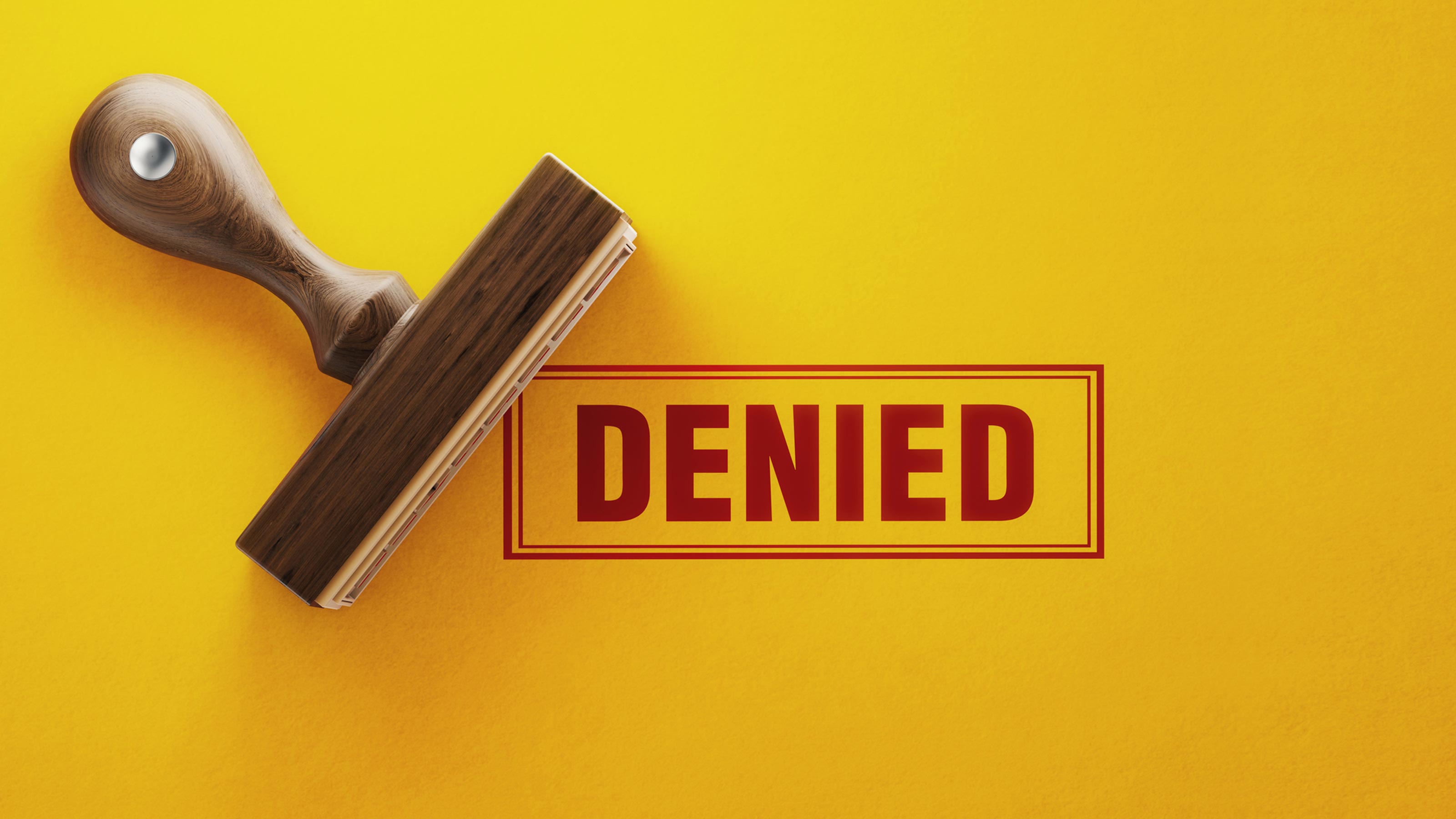3 Main Reasons Why the Government Denies Social Security Disability Benefits
To help improve your chances at being approved for SSDI benefits, it helps to better understand why so many applicants get turned down.


Social Security Disability Insurance (SSDI) is one of the least understood insurance policies available to U.S. workers. Many workers don’t realize they have the income protection SSDI provides or that they contributed to the coverage with every paycheck through FICA tax payments. Based on the available statistics, however, it is important that everyone is equipped with the knowledge of the program if and when a medical condition or disability makes it impossible for them to work.
One in four 20-year-olds will experience a period of disability at some point in their working life. If it becomes severe and has a long-term impact, SSDI provides a financial backstop of income, health insurance and even return to work assistance. Also, as we continue to recognize the effects of “long COVID” and other debilitating conditions, more and more individuals are turning to the vital SSDI program.
Unfortunately, fewer than 40% of the approximately 2 million people per year who seek SSDI will receive it after all is said and done, according to figures from the Social Security Office of Retirement and Disability Policy. About 67% of initial applications for SSDI will be denied by the Social Security Administration (SSA). During the first appeal (reconsideration), only 8% of former workers will be approved; and at the hearing level, just 2% of those still appealing for benefits will succeed.

Sign up for Kiplinger’s Free E-Newsletters
Profit and prosper with the best of expert advice on investing, taxes, retirement, personal finance and more - straight to your e-mail.
Profit and prosper with the best of expert advice - straight to your e-mail.
Many simply give up trying to navigate the confusing SSDI program, some manage to recover and go back to work, and others die while waiting months or years for a decision.
Three main issues are the primary contributors to the high denial rates and prolonged appeals process:
1. Applicants not meeting the work history requirements
While anyone who pays FICA payroll taxes long enough typically is insured for SSDI, it does not mean they are eligible for benefits. Just like private long-term disability insurance, there are key technical requirements. To meet the SSA definition of disability, one must have physical or mental impairments that prevent them from being unable to perform any substantial gainful activity (SGA) for at least 12 months or have a terminal diagnosis. SGA encompasses work performed for pay or profit, and for 2022, the monthly benefit one would receive after qualification is set at $1,350 a month, or $2,260 if you are blind.
An applicant must have worked five of the last 10 years, but this varies for younger individuals. The last requirement to meet is that an applicant must be at least age 21 and have not reached their full retirement age.
There are two quick ways to learn if you are insured for benefits before you apply. Discuss your situation with an experienced SSDI representative or go to www.ssa.gov and check out your My Social Security account benefit statement.
2. Applicants not having thorough documentation
The need for detailed medical evidence that documents a disability and its impact on the individual’s ability to perform SGA is a critical component of the SSDI application. Evidence should include diagnoses, medical tests and results, treatment history, prescription drugs, surgeries, ER and doctor visits, and other relevant medical details to demonstrate not just that you have a problem, but also that you have been getting regular medical treatment for your problem.
Solid medical evidence, combined with details about how a disability influences your activities of daily living, is especially important if you have an invisible disability, such as mental disorders, neurological conditions or cognitive dysfunctions caused by injury or disease. Regular monthly treatments and drug therapies with specialists and mental health professionals are an important part of your claim.
All medical evidence should support the claim that you meet an SSDI “medical listing.” These are details that help you prove your disability and are organized around diseases and body systems. In addition, the SSA follows complicated vocational guidelines that are applied based on age and education level.
3. Applicants not knowing they have the right to an SSDI representative
The SSA doesn’t inform initial applicants that they have the right to retain a representative to assist them early on, and most people try to navigate the complicated program solo. You need an advocate – someone you can trust will tell the story of your disability and its devastating effect on you and your family.
Fewer than 3 out of 10 applicants have an SSDI representative to help them apply. Those 3 people are 23% more likely to get their application approved, however, and that also means getting benefits in six months compared with a year or two. Of note, experienced advocates understand how to document for medical listings and usually help confirm your likely eligibility in advance.
If you are eligible for private long-term disability insurance coverage through your employer, consider yourself lucky. Your plan typically pays your representative’s fee for you if you must apply for SSDI.
Of course, these are especially unusual times for those with serious medical conditions that have worsened after a COVID-19 diagnosis. Representatives are taking on more SSDI cases resulting from long COVID symptoms that have exacerbated physical and mental impairments for people known as COVID long haulers. Long COVID may affect up to 30% of COVID patients, or an estimated 25 million people in the U.S., according to the American Academy of Physical Medicine and Rehabilitation –particularly those with respiratory disease, diabetes and cognitive issues.
One hopes they will never be impacted by a severe disability, and it’s not uncommon to resist the idea that it has changed your life and your ability to work. Like other insurance, however, SSDI is an investment you made when working. It’s there if you need it, even if only for a year or two while you recover from a major injury or a serious, short-term medical problem.
Get Kiplinger Today newsletter — free
Profit and prosper with the best of Kiplinger's advice on investing, taxes, retirement, personal finance and much more. Delivered daily. Enter your email in the box and click Sign Me Up.

Steve Perrigo, J.D., is Vice President, Sales and Account Management, for Allsup and has over two decades of experience and knowledge of the Social Security Administration (SSA) and its programs. He joined Allsup in August 2010 and helps clients understand their options when coordinating private disability insurance benefits with the Social Security program. Prior to joining Allsup, Steve Perrigo spent 17 years with the SSA in various roles of increasing responsibility.
-
 Starbucks 2025 Dress Code Changes: See the New Look
Starbucks 2025 Dress Code Changes: See the New LookThe 2025 Starbucks dress code change features a uniformed look as part of creating a more familar and friendly cafe experience.
By Sean Jackson
-
 Ray Dalio Is Ringing Alarm Bells About 'Something Worse Than a Recession'
Ray Dalio Is Ringing Alarm Bells About 'Something Worse Than a Recession'Bridgewater founder Ray Dalio has been sounding off about his concerns for the global economy as a result of tariffs and certain policies, as well as other factors.
By Alexandra Svokos
-
 Should You Hire a Public Adjuster for Your Insurance Claim?
Should You Hire a Public Adjuster for Your Insurance Claim?As natural disasters strike more often, insurance clients are asking, 'What should I do, or who should I hire, if my insurance company is jerking me around?'
By H. Dennis Beaver, Esq.
-
 Tips to Help Entrepreneurs Create Self-Sustaining Businesses
Tips to Help Entrepreneurs Create Self-Sustaining BusinessesWith the right processes and people in place, a truly sustainable business can be efficiently passed on to a successor and run profitably on its own.
By Jason L Smith, CEP®, BPC
-
 Navigating Annuity Taxation: A Guide for Financial Advisers
Navigating Annuity Taxation: A Guide for Financial AdvisersUnderstanding the essentials of taxation in retirement income strategies involving annuities helps ensure positive outcomes for clients.
By Jake Klima
-
 How Google Reviews Can Help (or Hurt) Financial Advisers
How Google Reviews Can Help (or Hurt) Financial AdvisersDon't leave your Google Business Profile unclaimed — someone else can make changes if they claim it. Also, here's what you can (and cannot) do with the reviews.
By Jeff Briskin
-
 How Baby Boomers and Gen Xers Are Redefining Retirement Living
How Baby Boomers and Gen Xers Are Redefining Retirement LivingBoth generations need to embrace change and leverage real estate as a dynamic asset in their retirement planning. Here's how financial advisers can help, too.
By David Conti, CPRC
-
 How Good Advisers Manage Risk in Challenging Markets
How Good Advisers Manage Risk in Challenging MarketsThey understand the difference between what might be real challenges to an investor's strategy and fear brought on by market volatility.
By Ryan L. Kirk, CFA®
-
 Financial Planning's Paradox: Balancing Riches and True Wealth
Financial Planning's Paradox: Balancing Riches and True WealthWhile enough money is important for financial security, it does not guarantee fulfillment. How can retirees and financial advisers keep their eye on the ball?
By Richard P. Himmer, PhD
-
 A Confident Retirement Starts With These Four Strategies
A Confident Retirement Starts With These Four StrategiesWork your way around income gaps, tax gaffes and Social Security insecurity with some thoughtful planning and analysis.
By Nick Bare, CFP®